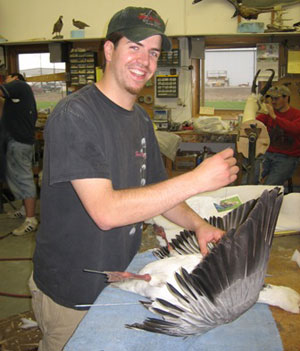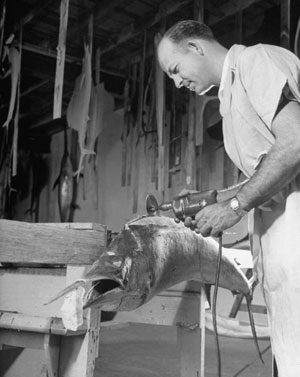Taxidermist
Tasks & duties

Taxidermists recreate dead animals, birds and fish into lifelike poses by:
-
skinning dead animals, birds or fish
-
cleaning flesh, mites and bacteria from skins
-
repairing broken or damaged skins and mounts
-
preserving skins with chemicals
-
designing and moulding artificial bodies
-
attaching skins to artificial bodies
They may also:
-
collect data and keep records about specimens
-
build display stands
-
discuss projects with clients
-
make reconstructions of extinct birds and animals
-
rebuild skeletons for research or display
-
give talks to public groups
Skills & knowledge

Taxidermists need to have:
-
knowledge of natural history, animal anatomy, biology and zoology
-
an understanding of animal behaviour, especially how they behave in the wild
-
knowledge of the Wildlife Act (1953)
-
knowledge of the chemicals used in taxidermy
-
photography and drawing skills for observing animals or birds in their natural habitat
-
model-making and sculpting skills, including basic woodworking and carving skills for making moulds and mounting bases
-
measuring skills
-
painting skills for finishing work
-
skill in using and caring for tools and equipment
-
knowledge of health and safety regulations
-
planning, organisational and record-keeping skills
Entry requirements
There are no specific entry requirements to become a taxidermist. Skills are learned on the job under the supervision of an established taxidermist.
Secondary education
There are no specific secondary educational requirements, but an interest in art and science subjects, especially biology, is helpful.
Tertiary education
There are no training courses available in New Zealand at present, but correspondence courses are available from the United States.
Useful experience
Useful experience includes:
-
voluntary work experience with a taxidermist
-
sculpting, painting, photography or model-making, especially with animal subjects
-
art or design courses
-
work with animals in their natural environment, including conservation work
-
bird and animal observation in the wild and in books
-
wildlife photography
For more information, please refer to Career Services.
Document Actions
